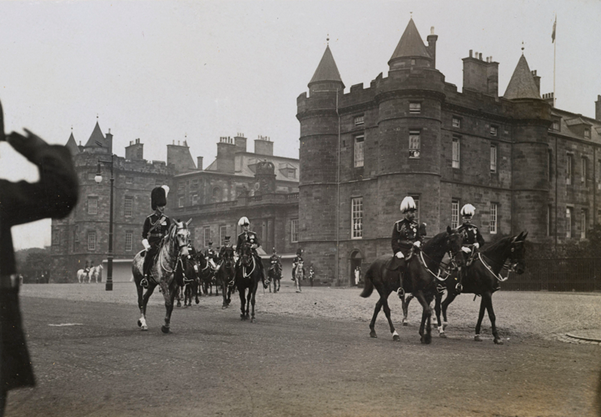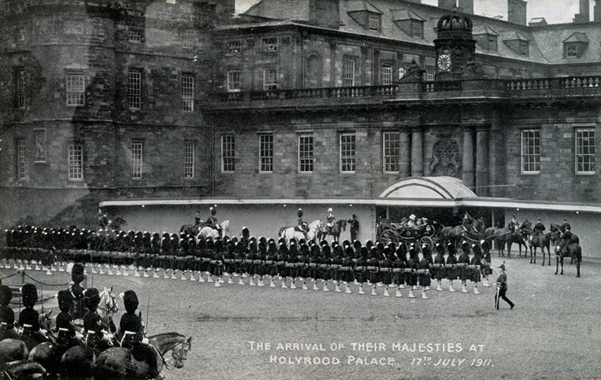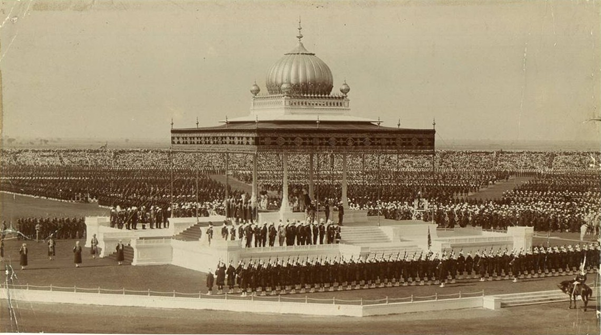Royal Visit
The form of the Royal Company’s ceremonial duties today largely dates from the first State Visit paid to Edinburgh by Their Majesties King George V and Queen Mary in July 1911. The King presented new Colours to the Royal Company in the garden of Holyroodhouse, inaugurated the Chapel of the Order of the Thistle in St Giles’s Cathedral and hosted a garden party at the Palace of Holyroodhouse at which ‘all the members of the Body Guard on duty were present.’
King George V paid eight State Visits to Scotland during his reign from 1910 to 1935. Following essential restoration and renovation work, the King and Queen Mary took up residence at the Palace of Holyroodhouse for the first State Visit to Scotland in July 1911. It was this visit that established the form and pattern for the Royal Company’s duties today as the Sovereign’s Body Guard in Scotland. The Palace remains the official residence of the King in Scotland and it is here that the Royal Company is most regularly on duty. Furthermore, by the gracious permission of the Sovereign, the Royal Company has long enjoyed the use of the Palace grounds in the summer months for shooting matches and archery practice.
The role of the Royal Company for the visit in 1911 was planned in great detail and publicised well in advance:
‘The Royal Company of Archers, the King’s Body Guard for Scotland, will take an important part in various functions in connection with the Royal visit. On the morning of Tuesday, 18th July, they will be inspected by the King within Holyrood Palace Gardens, and will be presented with new Colours by His Majesty. The present colours were given to the Royal Company in the year 1830 by King William IV, who made intimation by letter of the gift. This will be the first occasion on which they will receive colours from the hands of the King in person. An interesting ceremony will be the presentation by the Captain-General, in the name of the Company, of the ‘reddendo’ under Queen Anne’s Charter, which consists of three silver arrows. At the levée, the Archers will mount guard in the Throne Room and throughout the State rooms in which guests assemble, and perform the same functions as the Gentlemen-at-Arms on similar occasions in St James’s Palace. On Wednesday, the Archers will furnish a guard of honour within St Giles’ Cathedral in connection with the ceremony of the opening of the Thistle Chapel. In the afternoon they will furnish another guard of honour at the Usher Hall foundation stone ceremony; and in the evening they will furnish a guard of honour for the Court, similar to that at the levée. It is expected that there will be a large turnout of Archers, the number probably reaching 300.’
The Scotsman, 5 July 1911.
The 258 officers and members who had ‘placed their names upon the Duty Roster’ had much work to do. A comprehensive programme of drill and rehearsals ensued both in Edinburgh and London.
The parade for the presentation of new Colours by the King went well. The rain held off and the new Colours were duly consecrated. The King addressed the Royal Company:
‘I am very glad to have had this opportunity of inspecting the Royal Company of Archers, my Body Guard in Scotland, and I congratulate you upon today’s strong muster. It is an additional pleasure to me to present new Colours to replace those given to the Company by King William IV, and which have been carried in four successive reigns. I shall always watch over the welfare of the Royal Archers with that interest and solicitude shown towards it by my predecessors.’
Following the parade, the Captain-General, the Duke of Buccleuch, presented the Reddendo of three silver arrows to the King in the Palace Throne Room.
The inauguration of the Chapel of the Order of the Thistle in St Giles’ Cathedral, at which the Royal Company furnished a Guard of 36, and the laying of the foundation stone of Usher Hall, for which a Guard of 43 was mounted, also went without a hitch.
King George V’s State Visit ended on 20 July 1911 with a Garden Party, the first of these now well-established and most enjoyable annual occasions. However, members of the Royal Company attended as guests: the requirement for Archers to form ‘lanes’ and ‘circles’ to better enable members of the Royal Family to freely circulate amongst their guests was yet to come.
Investitures have now replaced Levées and new Colours have been presented just three times (1830, 1911 and 1966) but the duties of the Royal Company during Royal Week have changed little since 1911.
Duties Overseas
A unique opportunity arose from the State Visit of 1911: the only occasion on which the Royal Company has attended the Sovereign outside the United Kingdom. The Royal Company was informed that,
‘It was the King’s pleasure, that if any of them were to be at Delhi on this interesting occasion [the coronation (‘Durbar’) of King George V and Queen Mary as Emperor and Empress of India], they were to report themselves, in case His Majesty should desire them to take part as Members of the Scottish Body Guard, in any of the functions at the Durbar.’
And so it was that three members of the Royal Company came to be in attendance on Their Majesties in India in December 1911. Brigadier the Right Honourable the Earl of Mar and Kellie, the Honourable Norman MacLeod and the Honourable William L Graham were ‘placed close to His Majesty’s person, having precedence next below those of the Guard of Gentlemen-at-Arms.’ Court uniform with solar helmet and green plume was worn.



